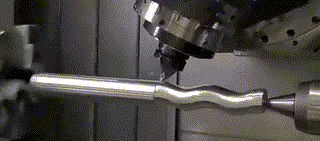technological innovation
The techniques you must know for aluminum processing
The deformation of aluminum component parts during processing can be caused by various factors, including material properties, part geometry, and production conditions. There are several main aspects to consider: deformation caused by internal stress in the raw material, deformation resulting from cutting forces and cutting heat, and deformation caused by clamping forces.

I. Process Measures to Reduce Machining Deformation
1. Reduce Raw Material Internal Stress
Using natural or artificial aging as well as vibration treatment can partially eliminate the internal stress in the raw material. Pre-machining is also an effective technique. For raw materials with excessive allowances, significant deformation may occur after processing. By pre-machining the excess material from the raw part and reducing allowances in various areas, not only can machining deformation in subsequent processes be reduced, but also some internal stress can be released after a period of time following pre-machining.
2. Improving Cutting Tool Performance
The choice of cutting tool material and geometric parameters has a significant impact on cutting forces and cutting heat. Correctly selecting the cutting tool is crucial for reducing workpiece deformation.
(1) Reasonably Select Cutting Tool Geometric Parameters.
①Front Angle: While maintaining blade strength, a larger front angle can be chosen to sharpen the cutting edge and reduce cutting deformation, allowing for smooth chip removal and a subsequent reduction in cutting forces and temperatures. Avoid using tools with a negative front angle.
②Back Angle: The back angle's size directly affects rear tool face wear and machining surface quality. Cutting thickness is a crucial factor in choosing the back angle. For rough milling, with a large feed rate, heavy cutting loads, and significant heat generation, good heat dissipation is required. Therefore, a smaller back angle should be selected. For finish milling, a sharp edge is required to reduce friction between the rear tool face and the machined surface and minimize elastic deformation. Hence, a larger back angle should be chosen.
③Helix Angle: To ensure smooth milling and reduce milling forces, a larger helix angle should be chosen whenever possible.
④Primary Clearance Angle: Slightly reducing the primary clearance angle can improve heat dissipation conditions and lower the average temperature in the machining zone.
(2) Enhancing Cutting Tool Structure.
①Reduce the number of teeth on the milling cutter and increase chip clearance space. Since aluminum has good plasticity, which results in significant cutting deformation during processing, ample chip clearance space is needed. Therefore, a larger radius at the bottom of the chip groove and fewer teeth on the milling cutter are preferable.
②Precision grind the teeth. The roughness value of the cutting edge should be less than Ra=0.4μm. Before using a new tool, gently grind the teeth before and after with a fine oilstone to eliminate burrs and slight serrations left during sharpening. This not only reduces cutting heat but also minimizes cutting deformation.
③Strictly control tool wear standards. After tool wear, the surface roughness of the workpiece increases, cutting temperatures rise, and workpiece deformation increases accordingly. Therefore, in addition to selecting tools made of wear-resistant materials, the tool wear standard should not exceed 0.2mm, as larger values can lead to chip accumulation. During cutting, the workpiece temperature should generally not exceed 100°C to prevent deformation.
3. Improving Workpiece Fixturing Methods
For thin-walled aluminum workpieces with poor rigidity, the following clamping methods can be used to reduce deformation:
①For thin-walled bushing-type parts: When using a three-jaw self-centering chuck or spring collet for radial clamping, the workpiece is prone to deformation once it is released. In such cases, a method involving axial end-face clamping with better rigidity should be employed. Use the part's internal hole for positioning, create a threaded through shaft, insert it into the part's internal hole, press it against the end face with a cover plate, and secure it with a nut. This method can prevent clamping deformation during external diameter machining and achieve satisfactory machining accuracy.
②For thin-walled sheet metal workpieces: It is best to use vacuum suction cups to achieve evenly distributed clamping force. Additionally, use a smaller cutting allowance during machining to effectively prevent workpiece deformation.
③Moreover, the stuffing method can be used. To increase the process rigidity of thin-walled workpieces, fill the interior of the workpiece with a medium to reduce deformation during clamping and cutting processes. For example, injecting a molten urea containing 3% to 6% potassium nitrate into the workpiece, and after machining, immerse the workpiece in water or alcohol to dissolve and remove the filler.
4. Reasonable arrangement plan
When high-speed cutting is performed, due to the large machining allowance and intermittent cutting, vibrations are often generated during the milling process, affecting machining accuracy and surface roughness. Therefore, the CNC high-speed cutting machining process is generally divided into the following stages: rough machining - semi-finishing - corner clearance machining - finishing, etc. For components with high precision requirements, sometimes secondary semi-finishing is required before finishing. After rough machining, the component can naturally cool down to eliminate the internal stress generated during rough machining and reduce deformation. The allowance remaining after rough machining should be greater than the deformation, generally ranging from 1 to 2mm. During finishing, the component's surface should maintain a uniform machining allowance, generally ranging from 0.2 to 0.5mm, to keep the cutting tool in a stable state during the machining process. This can significantly reduce cutting deformation, achieve good surface machining quality, and ensure product accuracy.
II. Operation skills to reduce processing deformation
Aluminum components can deform during the machining process. In addition to the reasons mentioned above, the operating methods are also crucial in practice.
1. For parts with large machining allowances, to ensure good heat dissipation conditions during machining and avoid heat concentration, symmetric machining is advisable. For example, if you have a 90mm thick plate that needs to be machined down to 60mm, machining one side and then immediately milling the other side to the final dimensions in one pass may result in a flatness of up to 5mm. However, if you use a symmetrical machining approach with multiple passes, machining each side in two steps to reach the final dimensions, you can achieve a flatness of 0.3mm.
2. If there are multiple cavities on sheet metal parts, it is not advisable to machine them one by one in sequence, as this can lead to uneven forces on the part and cause deformation. Instead, use a layered approach with multiple passes, trying to machine all the cavities on each layer simultaneously before moving on to the next layer. This helps distribute the forces evenly and reduces deformation.
3. Reduce cutting forces and heat generation by adjusting the cutting parameters. Among the three factors of cutting parameters, the depth of cut (known as "stepover") has a significant impact on cutting forces. If the machining allowance is too large and a single pass generates excessive cutting forces, it can lead to part deformation and affect the rigidity of the machine tool as well as tool durability. However, in CNC machining, high-speed milling is commonly used, which can overcome this challenge. By reducing the depth of cut and correspondingly increasing the feed rate while raising the machine tool's spindle speed, you can reduce cutting forces while maintaining machining efficiency.
4. Pay attention to the toolpath sequence. Rough machining emphasizes improving machining efficiency and the rate of material removal per unit of time, so climb milling (conventional milling) is generally used. This means removing excess material from the workpiece surface at the fastest speed and in the shortest time possible, forming the basic geometry required for finish machining. On the other hand, finish machining emphasizes high precision and quality, so conventional milling (climb milling) is more suitable. In climb milling, the cutting depth gradually decreases from maximum to zero, reducing work hardening and minimizing part deformation.

5. Deformation in thin-walled workpieces due to clamping is often unavoidable, even in finish machining. To minimize workpiece deformation, you can slightly release the clamping force just before reaching the final dimensions during finish machining. This allows the workpiece to recover to its original state, and then apply gentle clamping just enough to hold the workpiece in place (based on feel). This approach can help achieve optimal machining results. In general, it's best to apply clamping force at support points and in the direction of good workpiece rigidity, with the least possible clamping force while ensuring the workpiece remains secure.
6. When machining parts with cavities, especially with narrow channels, avoid plunging the milling cutter directly into the workpiece like a drill bit. This can result in insufficient chip evacuation space, leading to overheating, expansion, tool chipping, or tool breakage. Instead, use a drill bit of the same size or slightly larger to create holes before milling with an end mill. Alternatively, you can use CAM software to generate helical toolpaths.
The main factors affecting the accuracy and surface quality of aluminum part machining are deformation issues that can occur during the machining process. Overcoming these challenges requires operators to have experience and skill in handling these situations.
RELATED NEWS
- Not sure about the T4, T5, and T6 materials of aluminum profiles? This article h 2024-03-20
- How to use aluminum profile section design skills to solve extrusion production 2024-03-19
- Factors affecting the life of trimming and punching molds 2024-03-12
- Overview of Steel/Aluminum Welding Technology 2024-02-29
- Steel belt conveying direction 2023-09-26
CATEGORIES
LATEST NEWS
CONTACT US
Contact: Manager:Miss Jasmien
Phone: +8618825429836
E-mail: info@gdaa-cn.com
Whatsapp:+8618825429836
Add: Headquarter:No.8,Yixian Road,GDAA Mansion,Guangfo Zhicheng, Dali Town,Foshan,Guangdong.China
